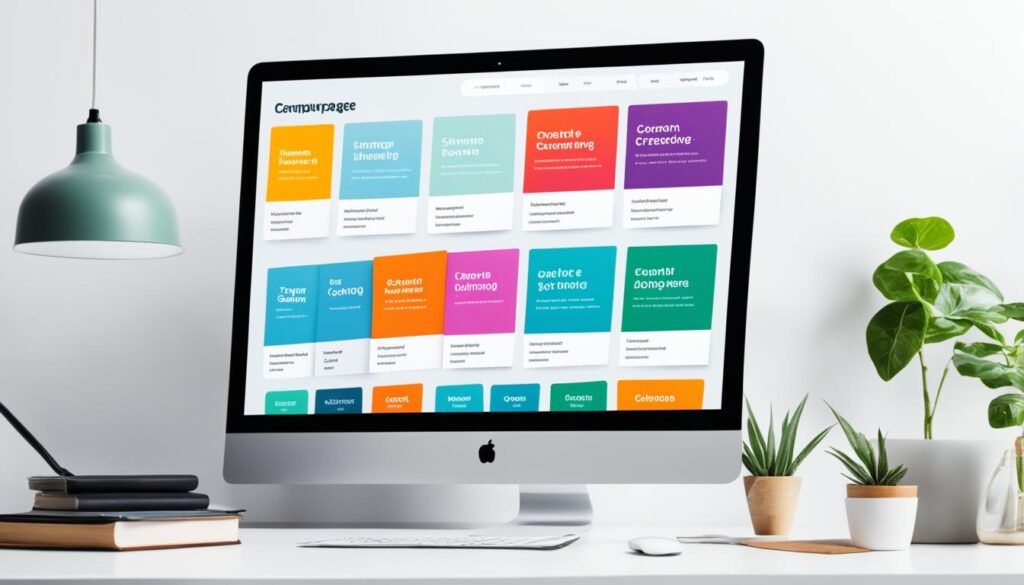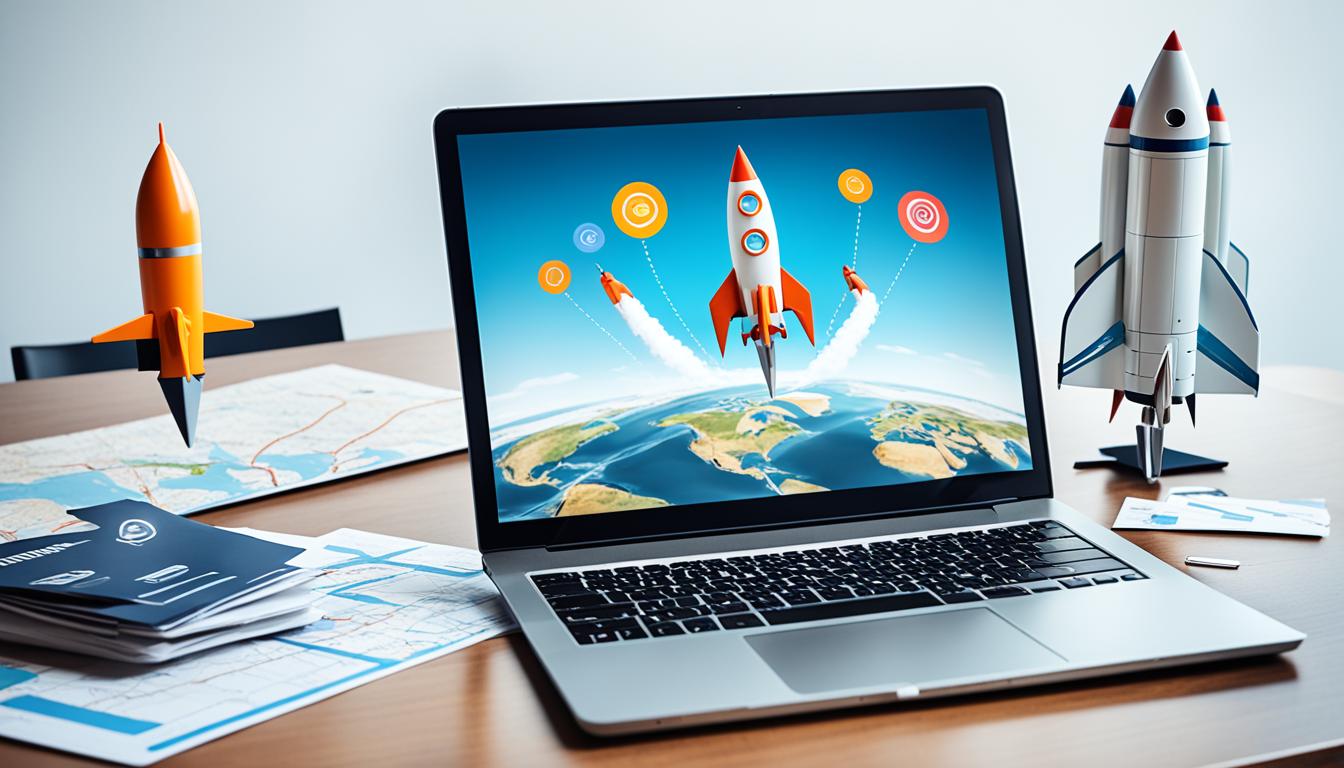Welcome to our comprehensive guide on landing page design tips for achieving high conversion rates. In the highly competitive world of digital marketing, the key to attracting leads effectively and converting them into loyal customers lies in creating a landing page that is carefully crafted. Whether you are starting a new business or are a seasoned marketing professional, improving your landing pages can significantly boost your conversion rates, leading to the growth of your business. In this tutorial, we will explore the top 10 landing page design tips that will provide you with the tools to create landing pages with high conversion potential, thereby enhancing your digital marketing strategies.
By implementing these proven techniques, you will be able to create landing pages that inspire trust, engage your target audience, and increase your chances of converting visitors into customers. From understanding the elements of a good landing page to designing compelling copy and effective call-to-action buttons, we have got you covered. So, let’s dive in and discover how to revolutionize your landing page design!
Key Takeaways:
- Optimizing your landing page design is crucial for achieving high conversion rates.
- Understanding the elements of a good landing page is essential for creating an effective design.
- Designing compelling copy and implementing effective call-to-action strategies are key to driving conversions.
- Offering free trials on landing pages can boost conversions and entice visitors to take action.
- Implementing best practices and analyzing landing page metrics are essential for continuous improvement.
50 Quick Tips for A Landing Page that Sells
- Avoid sending targeted traffic directly to your website; instead, utilize a landing page.
- Ensure the landing page has a singular, focused purpose and message.
- Align every element on the landing page with its theme and goal.
- Segment traffic by source (e.g., PPC ads, emails, social media, organic search, banner ads) and direct to distinct landing pages for better tracking and performance analysis.
- Segment offers by customer demographic, like not sending women’s perfume promotions to male customers.
- Determine the optimal length for your landing page to provide sufficient information for customer action, balancing between too short and too long.
- Match the main headline of your landing page with the advertisement that led the customer there.
- Use a clear, direct headline on the landing page, treating it as an advertisement for the advertisement.
- Prioritize important points at the beginning of the landing page.
- Place key elements within the top 300 pixels of the landing page.
- Eliminate all navigation elements except for the order button.
- Write in the second person, using “you” and “your” instead of “we” and “our.”
- Focus on clear, persuasive messaging rather than attempting to impress with creativity or clever wording.
- Use bullet points to make text easier to read.
- Edit for conciseness and remove unnecessary content.
- Show the product or service in its relevant context.
- Consider using video to potentially boost conversions by up to 80%.
- Incorporate real customer stories to enhance credibility.
- Offer free samples or trials for a try-before-you-buy experience.
- Provide a guarantee to minimize customer risk.
- For digital products (e.g., ebooks, software), offer previews to build trust and demonstrate product quality.
- Use directional cues (like arrows or images of people pointing) to draw attention to the order button.
- For longer landing pages, ensure directional cues guide users towards the order button below the fold.
- Create a prominent order button placed above the fold.
- Place a compelling message near the order button.
- Display a contact phone number to establish trust and real-person contact.
- Employ A/B testing to evaluate different messaging strategies based on customer preferences.
- Optimize for Mobile Devices: Ensure your landing page is responsive and looks great on smartphones and tablets.
- Use High-Quality Images: Incorporate professional, high-resolution images that are relevant to your product or service.
- Implement Fast Load Times: Optimize the page for quick loading to reduce bounce rates.
- Add Social Proof: Showcase customer testimonials, reviews, ratings, or media mentions to build trust.
- Keep Forms Simple: If using forms, make them easy to fill out with minimal required fields.
- Use Contrasting Colors: Ensure your call-to-action (CTA) button and key elements stand out with contrasting colors.
- Implement SEO Best Practices: Optimize your landing page for search engines with relevant keywords, meta descriptions, and alt text for images.
- Include Trust Badges: Display security badges, association memberships, or awards to enhance credibility.
- Offer Multiple Contact Options: Besides a phone number, include an email address, contact form, or live chat feature.
- Use White Space Effectively: Don’t clutter the page; use white space to make content easily digestible.
- Add a FAQ Section: Address common questions or concerns to preempt customer queries.
- Implement Exit-Intent Popups: Gently prompt users who are about to leave the page with a special offer or reminder.
- Track and Analyze Visitor Behavior: Use tools like Google Analytics to understand how users interact with your page and make data-driven improvements.
- Regularly Update Content: Keep your landing page fresh and relevant with regular updates.
- Align with Overall Branding: Ensure your landing page is consistent with your brand’s style, tone, and messaging.
- Use Psychological Triggers: Incorporate elements of urgency (like limited time offers) or exclusivity to encourage quicker decision-making.
- Optimize Headline and Subheadings: Make them compelling, clear, and reflective of the page’s value proposition.
- Include a Clear Value Proposition: Explain clearly and concisely why someone should take the desired action.
- Test Different Variations: Regularly test different versions of headlines, CTAs, images, and other elements to see what works best.
- Use Clear Progress Indicators: For multi-step processes, show users where they are and how much is left.
- Keep Brand Consistency Across Campaigns: Ensure your landing page aligns with the messaging and design of your ads or emails.
- Add a Privacy Statement: Reassure visitors that their personal information is safe and will not be misused.
- Regularly Back Up Your Landing Page: To prevent data loss and ensure you can quickly restore your page in case of technical issues.
Understanding What Makes a Good Landing Page
In order to create a successful online marketing campaign, it is essential to understand the key elements that make a landing page effective. A landing page is a specific web page that is designed to capture visitor information and convert them into leads or customers. Let’s explore the definition of a landing page and its role in digital marketing, as well as best practices for designing a high-converting landing page and common mistakes to avoid.
Defining a Landing Page
A landing page is a standalone web page that visitors are directed to after clicking on a specific call-to-action (CTA), such as an ad, social media post, or email link. Unlike other pages on your website, a landing page has a singular focus: to drive conversions. It is designed to capture visitor information, such as their name and email address, in exchange for an offer, such as a free download, discount coupon, or webinar registration.
The Role of Landing Page in Digital Marketing
Landing pages play a crucial role in digital marketing campaigns. They act as the first point of contact between your business and potential customers, providing an opportunity to make a strong impression and drive desired actions. A well-designed landing page can significantly increase conversion rates and ultimately contribute to the growth and success of your business.
Product or Service Presentation in a Landing Page
When designing a landing page, it is important to present your product or service in a compelling and persuasive way. This includes showcasing the unique value proposition, highlighting key features and benefits, and providing visual elements such as images or videos that engage and capture the attention of visitors. A good landing page should clearly communicate the value your product or service offers and convince visitors to take the desired action.
Key Best Practices for a Best Landing Page Design
To create a highly effective landing page, there are several best practices you should follow:
- Keep the design clean and clutter-free to enhance readability and focus on the main message.
- Create a clear and compelling headline that grabs the visitor’s attention.
- Include persuasive and concise copy that clearly communicates the benefits of your offer.
- Use high-quality visuals to support your message and make the landing page visually appealing.
- Optimize the landing page for mobile devices to ensure a seamless user experience.
Common Landing Page Mistakes That Hurt Conversion Rates
While designing a landing page, it’s important to be aware of common mistakes that can negatively impact conversion rates. Avoid these pitfalls to ensure your landing page is optimized for success:
- Having a cluttered design that overwhelms visitors and distracts from the main message.
- Using vague or confusing headlines that fail to clearly communicate the purpose of the landing page.
- Providing too much information and overwhelming visitors with excessive text.
- Having a weak or unclear call-to-action that doesn’t entice visitors to take the desired action.
- Not optimizing the landing page for speed, resulting in slow loading times that discourage visitors from staying on the page.
By understanding these best practices and avoiding common mistakes, you can create landing pages that capture your audience’s attention, engage them with compelling content, and drive conversions. The next section will guide you through the step-by-step process of creating a landing page that converts.
How to Create a Landing Page That Converts
In this section, we will discuss the step-by-step process of creating a landing page that converts. We understand the importance of a well-designed landing page in driving conversions and maximizing the success of your marketing campaigns. By following these guidelines, you can create landing pages that effectively engage your audience and inspire them to take action.
Selecting the Right Landing Page Builder
Choosing the right landing page builder is crucial to the success of your campaign. With so many options available, it can be overwhelming to make the right choice. Look for a landing page builder that offers customizable templates, intuitive drag-and-drop functionality, and seamless integration with your email marketing and CRM tools. Consider factors such as ease of use, flexibility, and the availability of advanced features like A/B testing and analytics.
Designing a Landing Page: The Template Selection
The design of your landing page plays a significant role in its success. Start by selecting a visually appealing and user-friendly template that aligns with your brand and campaign objectives. Opt for clean layouts, clear typography, and high-quality images. Use contrasting colors strategically to draw attention to key elements such as headlines and call-to-action buttons. Remember to keep the design consistent with your overall branding to provide a seamless user experience.
Making Your Landing Page Copy Convert
The copy on your landing page is essential in conveying your message and convincing visitors to take action. Craft compelling headlines that grab attention and clearly communicate the value proposition of your offer. Keep the content concise, focused, and benefit-driven. Use bullet points to highlight the key features and benefits of your product or service. Incorporate persuasive language and customer testimonials to build trust and reinforce the value of your offer.
Effective Call To Action (CTA) Tips for Landing Pages
A well-crafted call-to-action (CTA) is crucial in driving conversions on your landing page. Use strong, action-oriented language that compels visitors to take the desired action. Place your CTA prominently on the page and make it visually appealing and easy to locate. Use contrasting colors and a button design that stands out. Consider using persuasive copy and urgency elements like limited-time offers to create a sense of urgency and encourage immediate action.
Create Landing Pages That Offer Free Trials
Offering free trials on your landing pages can be an effective strategy to boost conversions. Free trials give potential customers the opportunity to experience your product or service firsthand, eliminating barriers to purchase. Highlight the benefits of your free trial and make it easily accessible on your landing page. Consider using a lead capture form to gather contact information before granting access to the trial, enabling you to follow up with interested prospects and nurture leads.
Best Practices and Landing Page Design Tips
In this section, we will dive deeper into the best practices and design tips that can enhance your landing page’s effectiveness. Implementing these strategies will not only boost conversion rates but also create a positive user experience, ultimately leading to higher customer engagement and sales.
One of the Best Ways to Boost Conversion Rates
When it comes to boosting conversion rates, one of the most effective techniques is optimizing your landing page for mobile devices. With the increasing use of smartphones and tablets, it is crucial to ensure that your landing page is responsive and mobile-friendly. This means that it should adapt seamlessly to different screen sizes and resolutions, providing a smooth and enjoyable browsing experience for mobile users.
To achieve this, prioritize simplicity in your landing page design. Keep the layout clean and uncluttered, with easy-to-read fonts and clear navigation. Minimize the number of form fields and make sure they are easy to fill out on smaller screens. By optimizing for mobile, you can capture the attention of a wider audience and maximize your conversion potential.
Good Landing Page Design Best Practices
Creating a visually appealing and user-friendly landing page is essential for attracting and retaining visitors. Here are some best practices to keep in mind:
- Keep the design consistent: Use consistent branding elements, such as colors, fonts, and imagery, to create a cohesive and professional look.
- Use high-quality visuals: Images and videos should be relevant, engaging, and high-resolution. They should also load quickly to prevent user frustration.
- Create compelling headlines and subheadings: Grab the visitor’s attention with persuasive headlines and concise subheadings that clearly communicate the value proposition.
- Utilize white space: White space helps to improve readability and highlights the important elements on your landing page. Avoid clutter and overcrowding.
- Include a strong call-to-action (CTA): Your CTA should be prominent, visually appealing, and clearly convey the desired action you want visitors to take.
The Power of Thank You Pages
Thank you pages play a crucial role in the overall user experience and can significantly impact conversion rates. These pages are displayed after a visitor completes a desired action, such as submitting a form or making a purchase.
Thank you pages present a valuable opportunity to further engage and convert your audience. They can provide additional information, offer exclusive content or discounts, or encourage visitors to explore other areas of your website. By leveraging the power of thank you pages, you can build trust, nurture customer relationships, and encourage repeat visits.
When designing your thank you page, consider the following:
- Express appreciation: Use personalized messaging to thank visitors for their action and express gratitude for their interest in your product or service.
- Offer additional value: Provide relevant resources or exclusive offers that can enhance their experience and incentivize further engagement.
- Encourage social sharing: Include social sharing buttons to encourage visitors to share their positive experience with their networks, amplifying your reach.
- Guide visitors to the next step: Clearly communicate the next steps and guide visitors towards the desired conversion goal, whether it’s exploring related products or signing up for a newsletter.

By incorporating these best practices and design tips into your landing page strategy, you can optimize your conversions, enhance user experience, and drive business growth.
Why the Landing Page Should Be a Standalone
In this section, we will examine why it is beneficial to have a standalone landing page rather than incorporating it into your website. A standalone landing page is a dedicated page that focuses solely on promoting a specific product, service, or offer. Unlike a website, which may have multiple pages and distractions, a standalone landing page provides a focused and streamlined experience for your visitors.
By using a standalone landing page, you can create a tailored and targeted message that aligns with the specific needs and interests of your audience. This allows you to deliver a more impactful and persuasive message, increasing the likelihood of conversions.
One of the main advantages of a standalone landing page is that it eliminates distractions. Your visitors won’t be tempted to click away or navigate to other sections of your website. Instead, they can fully concentrate on your offer and the desired action you want them to take, such as making a purchase or filling out a form.
A standalone landing page also provides better tracking and analytics capabilities. Since it is separate from your main website, you can easily monitor the performance of your landing page and gather valuable data to optimize its effectiveness. This data includes metrics such as conversion rates, bounce rates, and engagement levels.
Additionally, a standalone landing page allows for easy A/B testing and experimentation. You can test different elements, such as headlines, colors, images, and call-to-action buttons, to find the most effective combination that resonates with your audience. This helps you refine and improve your landing page over time.
How Many Landing Pages Do You Need?
The number of landing pages you need depends on your specific marketing goals and the diversity of your offerings. It is recommended to create separate landing pages for each distinct product, service, or offer you want to promote.
By having multiple landing pages, you can effectively target different segments of your audience and cater to their specific needs. Each landing page can be optimized with relevant keywords, unique value propositions, and tailored messaging, ensuring a more personalized experience for your visitors.
Creating multiple landing pages also allows you to track and measure the performance of each page individually. This way, you can identify which landing pages are driving the most conversions and optimize them accordingly to maximize your overall conversion rate.
However, it’s important to find the right balance. Having too many landing pages can be overwhelming and difficult to manage, especially if you have limited resources. It’s crucial to prioritize your offerings and focus on creating high-quality landing pages for your most important products or services.
Decoding The High Converting Landing Pages
In this section, we will unravel the secrets of high-converting landing pages and provide you with valuable insights to increase your landing page conversion rates. Understanding the elements that contribute to the success of a landing page is crucial for achieving your marketing goals.
Elements of High Converting Landing Pages
A high-converting landing page is crafted strategically to capture attention, engage visitors, and encourage them to take action. Here are some essential elements to consider:
- Compelling Headline: Your headline should be attention-grabbing and clearly communicate the value proposition.
- Clear Call-to-Action (CTA): Your CTA should be prominently displayed and use persuasive language to encourage visitors to take the desired action.
- Engaging Visuals: Images and videos that are relevant to your offer can help to capture the visitor’s attention and make your landing page more visually appealing.
- Concise and Persuasive Copy: Use clear and concise copy to communicate the benefits of your offer and address any potential objections.
- Trust Factors: Include testimonials, reviews, or trust badges to build credibility and trust with your audience.
- Mobile-Friendly Design: With the increasing use of mobile devices, it’s essential to ensure your landing page is optimized for mobile viewing to capture a larger audience.
By incorporating these elements into your landing page design, you can create a high-converting landing page that drives results.
Why Your Landing Page Doesn’t Convert: Common Problems
While a well-designed landing page can generate significant conversions, there are common problems that can hinder its effectiveness. Addressing these issues can help improve your overall conversion rates. Some common landing page problems include:
- Weak or Unclear Value Proposition: If your visitors don’t understand the value they’ll receive from your offer, they’re less likely to convert.
- Confusing Design or Navigation: A cluttered or confusing layout can result in visitors leaving your page without taking action.
- Overwhelming or Lengthy Forms: Asking for too much information or having a complicated form can discourage visitors from completing it.
- Lack of Social Proof: Testimonials, reviews, and case studies help build trust and credibility with your audience, and the absence of social proof can decrease conversion rates.
- Ineffective Call-to-Action: If your CTA is unclear, weak, or doesn’t stand out, visitors may not know what action to take.
Identifying and addressing these common problems will help increase the effectiveness of your landing page and improve conversion rates.
Understanding Landing Page Conversion Metrics
Measuring the performance of your landing page is essential to identify areas for improvement and optimize your conversion rates. The following landing page metrics are key to understanding your landing page’s effectiveness:
- Conversion Rate: The percentage of visitors who take the desired action on your landing page, such as making a purchase or filling out a form.
- Bounce Rate: The percentage of visitors who leave your landing page without taking any action or navigating to other pages.
- Click-through Rate (CTR): The percentage of visitors who click on a specific element, such as a CTA button or a link.
- Time on Page: The average amount of time visitors spend on your landing page before leaving.
By tracking these metrics and analyzing the data, you can identify areas for improvement and make data-driven decisions to optimize your landing page’s performance.
Differentiating Between a Sales Page and a Landing Page
While sales pages and landing pages have similar objectives, they serve different purposes in the sales funnel. Understanding the differences between the two is essential for creating effective marketing campaigns.
A sales page is a dedicated page that focuses on selling a specific product or service. It provides in-depth information, addresses objections, and often includes pricing details.
A landing page, on the other hand, is designed to capture leads or direct visitors to take a specific action. It typically has a simpler layout and is focused on achieving a single conversion goal.
While both sales pages and landing pages aim to convert visitors into customers, the approach and design differ based on the specific objectives of each page.
Examples of successful landing pages
Looking at successful landing page examples can provide valuable inspiration and insights into effective design and conversion strategies. Here are a few examples of landing pages that have achieved remarkable results:

These examples demonstrate various elements of successful landing pages, such as clear headlines, compelling copy, persuasive CTAs, and appealing visual design. Analyzing these successful landing pages can inspire and guide your own designs to increase conversion rates.
Bringing It All Together: Landing Page Examples That Sell
Product Page Vs Landing Page: Which Should You Use
When it comes to promoting your products or services online, you may be wondering whether a product page or a landing page is the better option. While both can be effective in their own ways, it’s important to understand the differences and choose the right one for your specific goals.
A product page is typically a dedicated page on your website where you showcase and provide detailed information about a specific product. It serves as a hub for potential customers to learn more about the features, benefits, and specifications of the product, with the ultimate goal of driving sales.

On the other hand, a landing page is a standalone page that is specifically designed to convert visitors into leads or customers. It focuses on promoting a specific offer, such as a free trial, ebook, or webinar, and typically includes a form or call-to-action button for users to take immediate action.
So, which should you use? The answer depends on your specific marketing objectives. If you’re looking to showcase and sell a single product, a product page may be the ideal choice. It allows you to provide comprehensive information and build trust with your audience.
However, if your goal is to capture leads, promote a limited-time offer, or drive conversions for a specific campaign, a landing page is the way to go. By keeping the focus on a single offer and eliminating distractions, a well-designed landing page can significantly improve your conversion rates.
Gaining Inspiration from The Best Landing Page Examples
When it comes to designing your own landing page, finding inspiration from successful examples can be incredibly valuable. By studying what works for others, you can identify effective design elements, messaging strategies, and call-to-action techniques that you can adapt for your own landing pages.
There are various resources you can turn to for landing page inspiration. Many websites, blogs, and online communities curate collections of high-converting landing page examples that you can explore. Take the time to analyze these pages and pay attention to the layout, color schemes, copywriting, and overall user experience.
However, it’s important to note that while inspiration is valuable, it’s essential to maintain a balance between drawing ideas from existing landing pages and ensuring that your design is unique to your brand. You want your landing page to stand out and speak to your target audience in a way that reflects your brand identity and values.
The Art of Landing Page Design in Action
Creating a high-converting landing page is not just about following a set of rules or best practices; it’s also an art form that requires a deep understanding of your target audience and effective design principles.
Successful landing page design involves a careful balance of visual elements, persuasive copywriting, and intuitive user experience. It’s about creating a seamless flow that guides visitors towards your desired action, whether it’s making a purchase, signing up for a newsletter, or downloading an ebook.
By leveraging the power of compelling headlines, captivating images, persuasive copy, and strategically placed call-to-action buttons, you can create landing pages that captivate your audience and drive conversions.
What to Look for in Landing Page Examples
When analyzing landing page examples, there are key elements to look for that can help you understand what makes a landing page successful:
- Clean and visually appealing design: A well-designed landing page should be visually engaging, with a clear hierarchy of information and an intuitive layout.
- Compelling and concise copy: The copy on a landing page should be persuasive, concise, and communicate the value proposition effectively.
- Strong call-to-action: The call-to-action (CTA) should be prominent, compelling, and aligned with the overall goal of the landing page.
- Social proof: Including testimonials, case studies, or reviews can help build trust and credibility with your audience.
- Mobile optimization: With the increasing use of mobile devices, it’s crucial to ensure that your landing page is fully responsive and provides a seamless experience across different screen sizes.
How to Test and Improve Your Landing Page Design
Creating an effective landing page is an ongoing process that requires continuous testing and improvement. By analyzing and testing different design elements, copy variations, and call-to-action strategies, you can optimize your landing page for maximum conversions.
A/B testing is a common technique used to compare two versions of a landing page and measure their performance. By testing one variable at a time, such as the headline, color scheme, or CTA button text, you can gather data and insights that will guide your optimization efforts.
Pay attention to conversion metrics such as bounce rate, click-through rate, and conversion rate to gauge the effectiveness of your landing page. Use web analytics tools and heatmaps to understand how users interact with your page and identify areas for improvement.
By continuously testing, refining, and improving your landing page design, you can maximize its potential to convert visitors into valuable leads and customers.
Conclusion
As we conclude our exploration of landing page design tips for high conversion, it is clear that optimizing your landing pages is essential for driving business success. By implementing the 10 tips discussed throughout this article, you can create landing pages that effectively convert visitors into customers.
Throughout this article, we have emphasized the importance of understanding what makes a good landing page and the best practices for designing one. We have discussed the role of landing pages in digital marketing and the common mistakes to avoid. Additionally, we have provided guidance on selecting the right landing page builder, designing compelling templates, crafting persuasive copy, and creating effective call-to-action buttons.
Furthermore, we have covered the benefits of offering free trials on landing pages and the power of thank you pages. We have explored the concept of standalone landing pages and the optimal number to use. We have also dived into the elements of high-converting landing pages, common problems that hinder conversion rates, and the importance of understanding landing page conversion metrics.
In the final sections, we have examined real-life landing page examples that effectively sell products or services. We have discussed the advantages of using a product page versus a landing page and provided tips on gaining inspiration from successful examples. Lastly, we have highlighted the importance of testing and improving your landing page design to maximize conversions.
By applying the knowledge gained from this article and implementing the recommended strategies, you will be well-equipped to create landing pages that drive high conversion rates and propel your business forward. Remember, a well-designed landing page is the key to converting visitors into loyal customers.
Tips for A Landing Page that Sells FAQ
Q: What are some best practices for creating an effective landing page?
A: Some best practices for creating an effective landing page include using a clean and compelling design, a clear call-to-action, persuasive copy, and a focus on the benefits of the offer.
Q: Do you have any tips for designing a high-converting landing page?
A: Yes, some tips for designing a high-converting landing page include using a clear headline, relevant imagery, a simple form, social proof, and a compelling offer.
Q: Why do I need a landing page for my website?
A: A landing page is a powerful way to direct visitors to a specific offer or action, separate from your main website, and can help increase conversions and track the effectiveness of your marketing efforts.
Q: How can I optimize my landing page for better results?
A: You can optimize your landing page by testing different elements, such as the headline, call-to-action, form length, and layout, and analyzing visitor behavior to make data-driven improvements.
Q: What are some key elements that should be included on a landing page?
A: Some key elements to include on a landing page are a strong headline, compelling imagery, a clear call-to-action, persuasive copy, social proof, and a simple form.
Q: How can I drive traffic to my landing page?
A: You can drive traffic to your landing page through various channels such as email marketing, social media promotion, pay-per-click advertising, search engine optimization, and content marketing.
Q: What are the best landing page design tips to follow?
A: The best landing page design tips include keeping the design clean and uncluttered, using contrasting colors to draw attention to key elements, and ensuring mobile responsiveness for a seamless user experience.
Q: How many different landing pages should I create for my website?
A: The number of different landing pages you create depends on the variety of offers or campaigns you want to promote. It’s recommended to create separate landing pages for each unique offer or target audience.
Q: What are some space-saving techniques for optimizing my landing page layout?
A: To optimize your landing page layout, consider using collapsible sections, accordion menus, or modal pop-ups to present additional information without cluttering the main content area.
How Can Landing Page Design Tips Be Used to Promote Eco-Friendly Advertising Strategies?
When creating landing page designs for advertising and ecoimpact strategies, it is important to incorporate elements that reflect the eco-friendly values of the brand. This can be done through the use of sustainable imagery, eco-friendly color schemes, and messaging that promotes environmentally conscious practices.
Q: How can I ensure that my landing page resonates with visitors and encourages action?
A: To ensure your landing page resonates with visitors and encourages action, make sure your messaging is compelling and benefits-focused, and use persuasive visuals and social proof to build trust and credibility.










